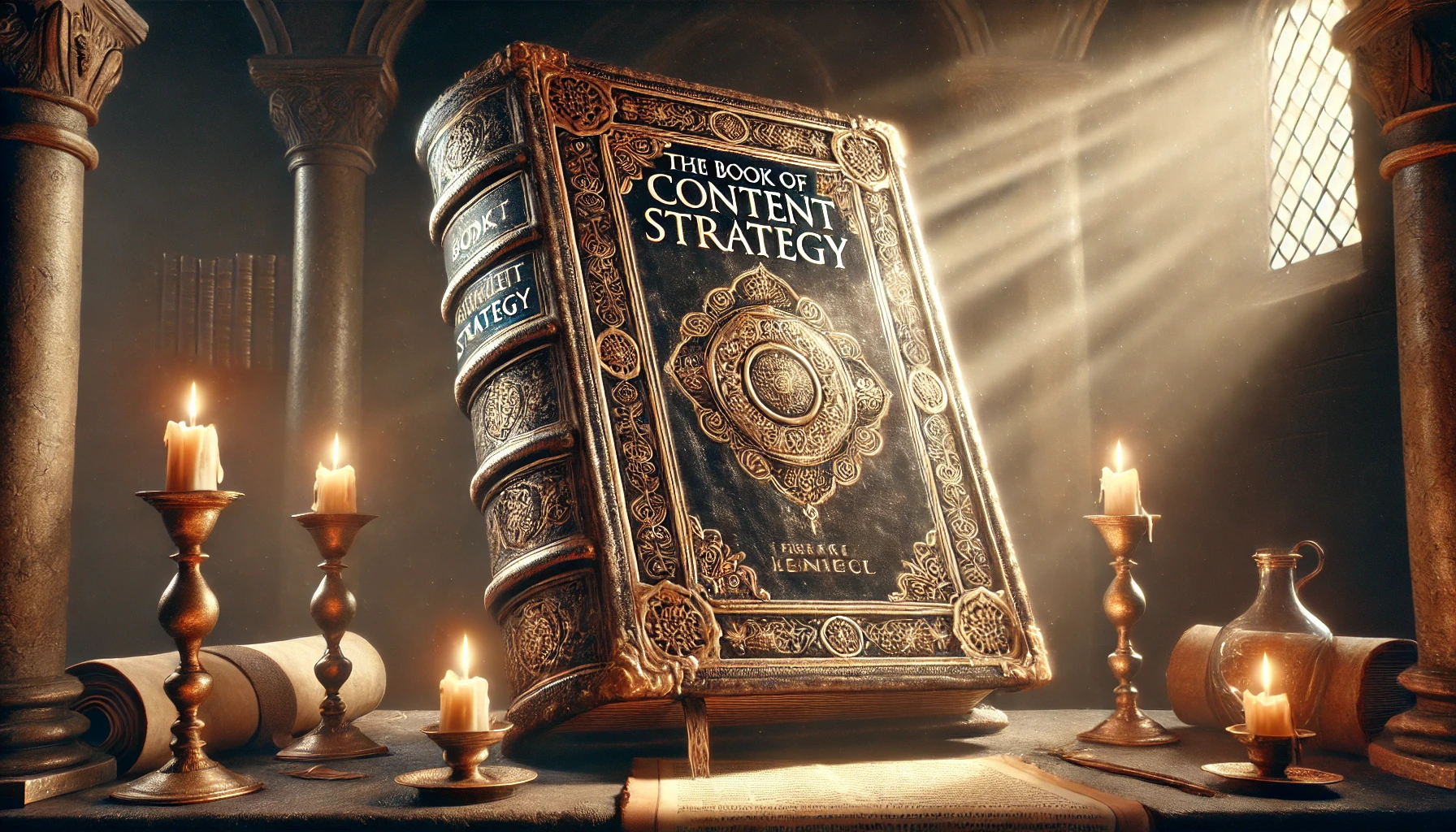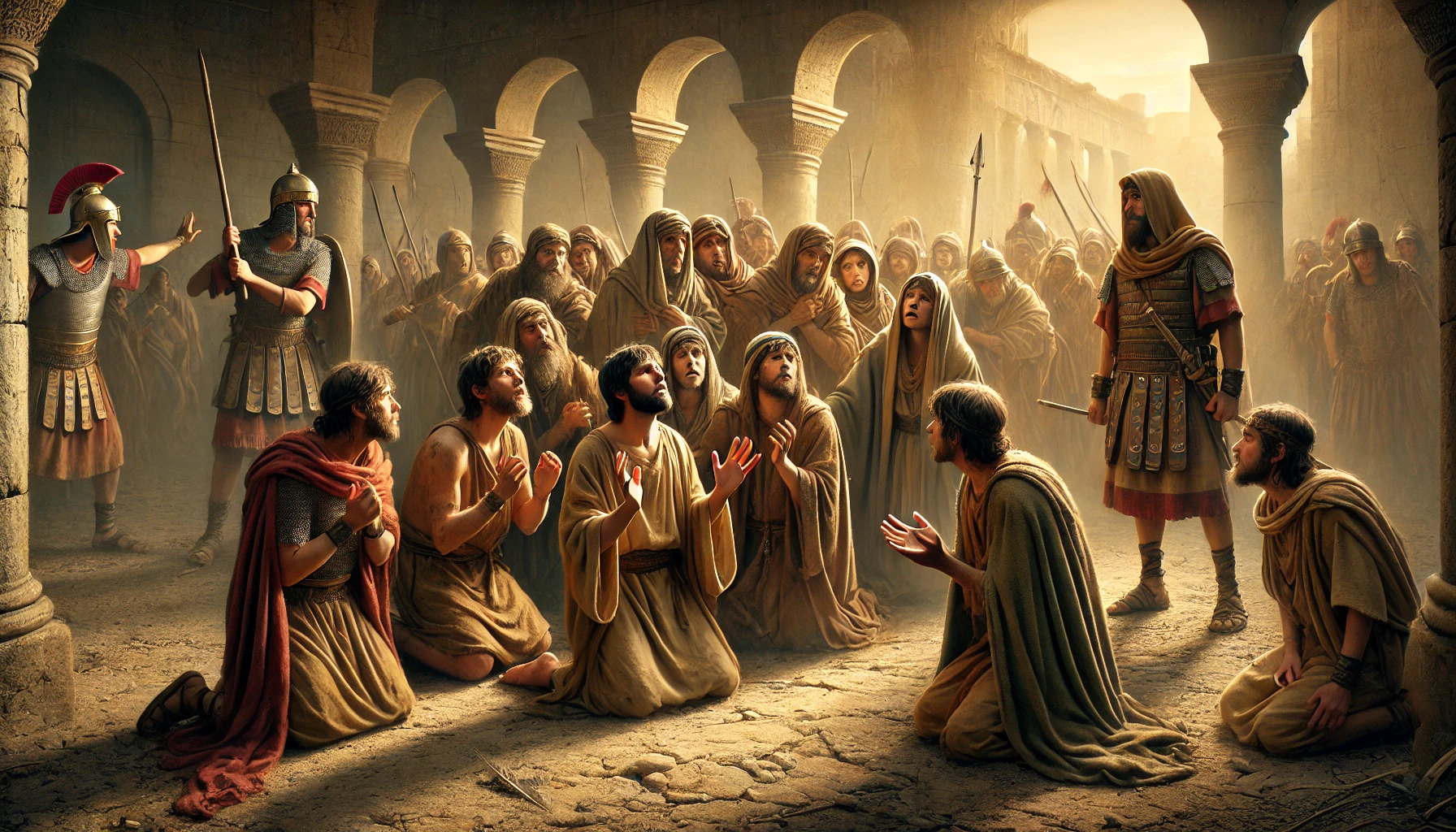
Welcome to The SEO Scriptures, a sacred guide designed to illuminate your path through the intricate world of search engine optimisation. Here, you will find divine wisdom on mastering keywords, crafting compelling content, and building authority, empowering you to thrive in the digital realm. May these teachings inspire your journey to success online.
In the beginning, there was chaos upon the digital realm. And the wise among the marketers did cry out for guidance, that their pages may rise above the tumultuous waves of the search engines. Lo, unto them was given the scriptures of SEO, a beacon of wisdom to guide their path.
Yea, within these hallowed writings are revealed the mysteries of the algorithm and the paths to organic ascension. Verily, the commandments of keywords, the parables of content, and the laws of engagement were set forth to enlighten all who would follow.
And it is written, those who heed the teachings of the Scriptures shall see their ranks ascend in the sight of the search engines. For the way of optimisation is not through vanity or deceit, but through the diligent weaving of relevance, trust, and experience, that the searchers may find rest for their queries.
Behold, the Scriptures do speak of the sacred tools: analytics, that the numbers may be read and understood; keywords, that the searchers may be drawn to thee; and links, that authority may be conferred upon thee. Yea, these are the pillars upon which the righteous digital builder stands.
Blessed are they who labour according to the wisdom of the Scriptures, for their websites shall flourish like a tree planted by streams of water. Their traffic shall increase, their conversions shall multiply, and their businesses shall be as cities set upon a hill, which cannot be hidden.
Thus saith the Scriptures: Let those who seek the summit of the search engines follow these truths, and they shall not stumble. For the path of white-hat SEO is the path of light, and the faithful shall see their efforts rewarded in due season.
Come, ye seekers of higher ranks and conversions, and partake of the wisdom that hath been set before thee. Follow The SEO Scriptures, and let thy pages rise like the morning sun upon the land.
Go forth, and be ye fruitful in SEO, for the Scriptures of SEO shall be thy guide and thy strength.
- Chapter 1: The Beginning of Search
- Chapter 2: The Rise of Keywords
- Chapter 3: The Craft of Quality Content
- Chapter 4: The Kingdom of Keywords
- Chapter 5: The Scroll of Content Creation
- Chapter 6: The Book of Link Building
- Chapter 7: The Book of Technical SEO
- Chapter 8: The Book of Content Strategy
- Chapter 9: The Book of Conclusion
- Chapter 9: The Book of Disclaimer

Chapter 1: The Beginning of Search
In the beginning, the search engines were formed, and the users did seek knowledge upon the digital realm.
- The seekers, wandering through the vast expanse of the internet, were overwhelmed by the multitude of information. They yearned for guidance, for a way to distil the noise into clarity.
And it came to pass that the seekers desired answers to their enquiries, and the engines provided them with results.
- With each query typed into the sacred box, the search engines responded, sifting through the sands of data to uncover the treasures hidden within the depths of the web.
- Thus began the sacred dance between seeker and engine, a relationship built on the quest for knowledge and understanding.
Thus, it was decreed that those who would be found must employ the wisdom of Search Engine Optimisation (SEO).
- For the seekers, not all paths were equal; some led to wisdom, while others led to confusion. And so, the art of SEO arose, a practice to enhance visibility and guide the seekers toward the light of knowledge.
- This wisdom involved understanding how search engines operated, what made content valuable, and how to communicate effectively with the algorithms that dictated visibility.
For the internet was vast, and without guidance, the seekers wandered aimlessly.
- The realms of cyberspace were filled with untamed data, and many a seeker found themselves lost in the wilderness of information.
- The importance of organisation and clarity emerged, revealing that not only must content be created, but it must also be structured in a way that aligns with the desires of the search engines.
And it was proclaimed, “Let there be light!” And the light was the search engine, illuminating the path for the seekers.
- Search engines became the guiding stars, shedding light on the darkest corners of the internet. They transformed chaos into order, bringing forth the ability to search, discover, and learn.
- This light was powered by complex algorithms, designed to evaluate, rank, and present the most relevant content to those who sought answers.
From this day forth, let those who seek understanding learn the ways of the algorithm, that they may be seen and heard in the digital congregation.
- Understanding the algorithms became paramount; they were the gatekeepers of visibility and traffic. The wise learned that by aligning their content with the principles of the algorithms, they could ensure their voices were not lost amidst the clamor.
- Knowledge of the algorithms’ updates, changes, and rankings became essential for any who sought to thrive in the digital landscape.
And lo, the algorithm was a living entity, ever-changing, much like the seasons.
- As the seasons bring forth growth and decay, so too did the algorithm evolve, adapting to the needs and behaviors of the seekers. The wise remained vigilant, always attuned to the signals of change.
- The algorithm took into account factors such as relevance, authority, and user experience, calling upon the creators of content to adapt and innovate continuously.
In those days, the righteous sought to create content that resonated with the hearts of the seekers.
- Content became the cornerstone of engagement, a means to connect, educate, and inform. It was not enough to produce content; it must be meaningful and purposeful, addressing the pain points and questions of the audience.
- Thus, the importance of high-quality content became evident, for it was through valuable information that the seekers would find answers and solutions.
Therefore, let it be known: the keywords shall be the vessels through which seekers shall find thee.
- Keywords became the guiding terms that shaped the content’s purpose and direction. Through diligent research and understanding of the seekers’ language, the righteous would craft messages that resonated with their audience.
- The skillful use of keywords would unlock the gates of visibility, drawing seekers closer to the light of knowledge.
And so the foundations were laid, and the path was illuminated for those who would heed the call.
- The journey of SEO began as a quest for understanding, a commitment to learning, adapting, and evolving alongside the ever-changing digital landscape.
- Those who embraced the principles of SEO would find themselves not just as content creators, but as guides leading seekers toward enlightenment.
Rejoice, for the digital world is ripe with opportunity!
- With the tools of SEO at their disposal, the righteous could reach across vast distances, sharing knowledge and insight with seekers far and wide.
- The age of digital enlightenment had dawned, and the seekers, armed with the wisdom of the SEO Scriptures, would embark on their journeys, forever changed by the knowledge they discovered.

Chapter 2: The Rise of Keywords
In the unfolding narrative of the digital realm, there arose a pressing need for clarity, for the seekers had questions that sought answers.
- As seekers traversed the vast landscapes of the internet, they typed enquiries into the sacred search bar, summoning forth the power of the keywords hidden within their thoughts.
- Thus, the keywords became the lighthouses guiding the seekers to the shores of knowledge.
And the wise did discern that keywords were not mere words, but the essence of intent—the bridge between seeker and knowledge.
- Each keyword was a thread woven into the fabric of content, representing the desires, interests, and inquiries of the audience.
- The righteous understood that to unlock the gates of visibility, one must first grasp the power of these threads.
Therefore, it was said, “Let the seekers be heard!” And the voices of the seekers became the foundation of keyword research.
- The practice of keyword research was established, a quest to uncover the phrases and terms that the seekers used to express their desires.
- Tools emerged to aid in this journey, revealing search volumes, competition levels, and the intentions behind each keyword.
Verily, the righteous did learn to categorise keywords into three distinct realms: short-tail, long-tail, and semantic.
- Short-tail keywords were those simple phrases, often consisting of one or two words, embodying broad concepts but yielding high competition.
- For example, the word “shoes” summoned a multitude of options, yet it lacked specificity, scattering the seekers in all directions.
- Long-tail keywords emerged as the wise sought to narrow their focus. These phrases, typically three or more words, were specific and targeted, often indicating a clear intent.
- For instance, “best running shoes for flat feet” became a beacon for seekers in search of tailored recommendations.
- Semantic keywords arose, encompassing variations and related terms, expanding the reach of content beyond exact phrases to capture the broader conversation surrounding the primary keyword.
- This allowed content creators to weave richer narratives, resonating with the seekers on multiple levels.
And it was decreed that the righteous must understand the intent behind the keywords.
The four pillars of search intent emerged: informational, navigational, transactional, and commercial investigation.
- Informational intent was characterised by seekers desiring knowledge, asking questions, and seeking answers.
Such as “how to tie a tie” or “what is SEO.” The content designed for this intent must enlighten and educate.
- Navigational intent arose when seekers sought to find specific websites or brands.
They would enter terms like “Facebook login” or “Amazon.” Here, the focus shifted to ensuring easy access to known entities.
- Transactional intent indicated a readiness to make a purchase or complete a desired action.
Terms like “buy shoes online” or “best SEO tools” signified the seekers’ intent to engage in commerce.
- Commercial investigation found seekers weighing their options before making a decision, seeking comparisons and reviews.
Queries like “best running shoes reviews” demonstrated the need for insightful content that would guide seekers in their choices.
And thus, the righteous began to weave their content around these sacred keywords, aligning their messages with the desires of the seekers.
- Content became a tapestry, interlaced with keywords that mirrored the voices of the audience, ensuring that the seekers would find solace and answers in their inquiries.
- The judicious use of keywords within headings, subheadings, and body text became paramount, for each placement was a beacon guiding the seeker to the answers they sought.
Yet the wise did not neglect the power of keyword density, knowing that moderation is the key to balance.
- They understood that overloading content with keywords led to a dark path known as keyword stuffing—a practice that bore the wrath of the search engines.
- Thus, the righteous employed keywords naturally, allowing their content to flow with grace, providing value without sacrificing clarity.
And it was proclaimed, “Diversify thy keywords!” for the righteous understood the necessity of variation in their keyword strategy.
- Synonyms, related terms, and phrases resonating with the audience became essential to expanding reach and engagement.
- By exploring the myriad ways seekers expressed their desires, content creators could resonate with a broader audience, drawing them closer to the truth.
In those days, the concept of local keywords emerged, for the seekers desired to find knowledge within their communities.
- The wise recognised the significance of geographic terms, understanding that many seekers were in search of local solutions.
- Phrases like “SEO consultancy in London” or “best pizza near me” became vital, calling upon the power of location to connect seekers with relevant businesses and services.
And lo, as the seasons changed, so did the strategies surrounding keywords.
- The righteous learned that keyword trends would shift over time, and adapting to these changes was crucial for maintaining visibility.
- The diligent monitored their keywords, utilising tools and analytics to gauge performance, refine strategies, and embrace the evolving landscape of search.
Therefore, let it be known that the power of keywords is both profound and transformative.
- The righteous who embrace the art of keyword research and application shall unlock the gates of visibility, guiding seekers toward the content they desire.
- Through keywords, they shall bridge the gap between intention and fulfillment, elevating their voices in the cacophony of the digital realm.
Thus, as the sun sets on this chapter, remember: in the realm of SEO, the keyword is your staff, guiding you through the wilderness, illuminating your path, and leading the seekers to the oasis of knowledge.
- Let the righteous wield this staff with wisdom, understanding its significance, and employing it diligently to fulfill the quest for truth in the digital landscape.

Chapter 3: The Craft of Quality Content
In the sacred journey of search engine optimisation, it came to pass that the creation of quality content was exalted above all else.
- For it was declared that content is the lifeblood of the digital realm, nourishing the seeker’s quest for knowledge, truth, and solutions.
- The wise knew that without quality content, the foundation of SEO would crumble, leaving seekers lost in the wilderness of information.
And lo, the first principle of quality content was established: Purpose.
- Each piece of content must have a clear intention, crafted to serve the needs of the seekers who would read it.
- Whether it be to inform, educate, entertain, or persuade, the content must resonate with its audience, answering their questions and fulfilling their desires.
Verily, the righteous understood that to achieve this purpose, one must engage in thorough research.
- The diligent examined the thoughts and enquiries of the seekers, uncovering their pain points and desires.
- The practice of audience research emerged, allowing content creators to gain insight into the preferences, challenges, and needs of their target audience.
And it was said, “Let thy content be relevant and timely!”
- The wise recognised that content must align with current events, trends, and topics that interest their audiences.
- By staying abreast of industry developments, creators could produce content that was not only informative but also timely and engaging.
Thus, the second principle of quality content was revealed: Originality.
- The seekers yearned for fresh perspectives, unique insights, and original thoughts.
- Plagiarism was shunned, for the righteous understood that duplicating the work of others bore the wrath of search engines and diminished the value of their own contributions.
And it was declared that content must be crafted with clarity and coherence.
- The righteous sought to communicate their messages in a clear, concise, and logical manner.
- Each piece of content should flow seamlessly, guiding the seeker through its narrative, ensuring that every word serves a purpose and contributes to the overall understanding.
Behold, the importance of structure was revealed!
- The wise structured their content using headings, subheadings, and bullet points to enhance readability and comprehension.
- By breaking down complex ideas into digestible sections, the seekers could easily navigate the content, absorbing its wisdom without feeling overwhelmed.
The righteous also understood the power of storytelling in their craft.
- It was proclaimed that stories captivate the hearts and minds of seekers, making content relatable and memorable.
- Through narratives, personal experiences, and vivid imagery, content creators could evoke emotions, drawing seekers closer to their messages and fostering a sense of connection.
And it was said that the righteous must employ visual elements to enhance their content.
- Images, infographics, and videos served as powerful tools to complement the written word, breaking up text and providing additional context.
- The wise knew that a well-placed visual could evoke emotions, clarify complex concepts, and ultimately engage the seeker on multiple levels.
In the realm of content, optimisation was proclaimed a necessity.
- The righteous carefully integrated their keywords, ensuring that each piece of content was discoverable by search engines while maintaining a natural flow.
- They understood that keyword stuffing was a sin, as it marred the quality of the content and led to penalties from the search engines.
Furthermore, the importance of meta tags and descriptions was revealed.
- The wise crafted compelling meta titles and descriptions that accurately represented their content and included relevant keywords.
- These elements served as the initial invitation for seekers to engage, enticing them to click and explore further.
And lo, the third principle of quality content emerged: Engagement.
- The righteous understood that to capture the hearts of their audience, their content must spark interest and encourage interaction.
- Calls to action, questions, and prompts for discussion invited seekers to engage with the content, fostering a sense of community and dialogue.
Thus, it was decreed that the righteous must update and refresh their content regularly.
- Stale content was akin to stagnant water, providing no nourishment to the seekers.
- The wise revisited their existing pieces, ensuring they remained relevant, accurate, and aligned with current trends and insights.
The practice of link building was also emphasised, for the righteous understood the importance of connections.
- Internal linking strengthened the structure of their content, guiding seekers to related articles and resources within their domain.
- External linking to authoritative sources lent credibility to their work, showing seekers that their insights were grounded in truth and expertise.
And behold, the significance of user experience (UX) emerged as a guiding principle in the craft of content.
- The righteous recognised that the design and functionality of their website directly impacted the seeker’s experience.
- A well-structured, visually appealing, and easily navigable site ensured that seekers could engage with content seamlessly, free from distractions.
Thus, as the sun set on this chapter, it was clear that the craft of quality content was a sacred duty.
- The righteous who poured their hearts and souls into creating meaningful, engaging, and valuable content would reap the rewards of visibility, engagement, and trust.
- Let the seekers find solace in the wisdom shared through the written word, and let the righteous continue their quest for truth and knowledge in the digital realm.
Therefore, as you embark on your journey of content creation, remember: quality content is the essence of SEO.
- It is the foundation upon which your digital presence is built, the beacon that draws seekers to your door, and the nourishment that satisfies their quest for knowledge.
- Embrace the craft, for in doing so, you shall fulfil your purpose as a guide in the vast landscape of information.

Chapter 4: The Kingdom of Keywords
In the beginning, there was the Word, and the Word was the key to discovery.
- For in the Kingdom of SEO, keywords were established as the sacred language through which seekers expressed their desires, queries, and needs.
- The wise recognised that understanding this language was paramount to guiding seekers towards their digital offerings.
Thus, the first principle of the Kingdom of Keywords was proclaimed: Research.
- The righteous sought to unearth the words and phrases that resonated with their audience, for these were the gateways to visibility and engagement.
- Through diligent research, they uncovered the intent behind seekers’ searches, discerning the specific phrases that drove traffic to their content.
And behold, the tools of the trade were bestowed upon the faithful.
- The wise employed tools such as Google Keyword Planner, SEMrush, and Ahrefs to reveal the hidden treasures of search volume, competition, and related keywords.
- Through these tools, they could gain insight into the thoughts of the seekers, understanding what they sought and how they sought it.
The righteous understood that there were different types of keywords, each serving its purpose in the vast ecosystem of search.
- Short-tail keywords, broad and general, served as the foundation of the Kingdom, casting a wide net to attract seekers.
- Yet, it was the long-tail keywords, more specific and detailed, that held the key to conversion, for they captured the intentions of seekers on their journey to fulfilment.
Therefore, the wise cultivated their strategies, embracing the art of keyword selection.
- They focused on keywords with a balance of search volume and competition, seeking phrases that would yield a fruitful harvest without the burden of excessive rivalry.
- The righteous understood that relevance was key; the chosen keywords must align with the content, reflecting the true essence of their message.
As they ventured deeper into the kingdom, they discovered the importance of keyword intent.
- The seekers’ intentions were classified into three categories: informational, navigational, and transactional.
- The wise aligned their content with the intent of the seekers, ensuring that those in search of knowledge found informative articles, those seeking direction reached their pages, and those desiring to purchase encountered compelling offers.
Thus, the second principle of the Kingdom of Keywords was revealed: Optimisation.
- The righteous understood that merely selecting keywords was not enough; they must be woven seamlessly into the fabric of their content.
- Keywords were to be integrated into titles, headings, and throughout the body text, while ensuring the natural flow and readability of the message remained intact.
And it was said, “Do not forget the power of the meta tags!”
- The wise crafted compelling meta titles and descriptions, embedding their chosen keywords to invite seekers into their realm.
- These elements acted as guiding lights, attracting visitors to their pages from the vast darkness of search results.
The righteous also recognised the value of LSI (Latent Semantic Indexing) keywords.
- These related terms and phrases enriched the content, reinforcing the primary keywords and enhancing the relevance of their messages.
- By incorporating LSI keywords, the wise demonstrated their depth of knowledge and understanding of the subject matter, earning the trust of both seekers and search engines alike.
As they honed their craft, the importance of keyword density became clear.
- The righteous understood that while keywords should be present, they must not overwhelm the content.
- A balanced approach, where keywords appeared naturally and authentically, ensured that the message remained compelling without incurring the wrath of search engine penalties for over-optimisation.
The third principle of the Kingdom of Keywords was established: tracking and analysis.
- The wise monitored the performance of their chosen keywords, utilising analytics tools such as Google Analytics and Search Console to gain insights into user behaviour.
- By tracking rankings, click-through rates, and conversions, they could adjust their strategies, nurturing their keywords to flourish in the ever-changing landscape of search.
And behold, the practice of competitor analysis emerged as a vital strategy.
- The righteous observed the keywords that their competitors targeted, learning from their successes and shortcomings.
- This insight allowed them to refine their own keyword strategies, seizing opportunities where others faltered.
As the sun rose over the Kingdom of Keywords, the wise understood that local SEO also held great significance.
- For those seeking guidance within their communities, the inclusion of local keywords was essential.
- They embraced terms that encompassed their geographical locations, ensuring that seekers could find their offerings amidst the sea of competitors.
The importance of voice search optimisation emerged as the kingdom expanded to embrace new technologies.
- The righteous prepared for the rise of voice-activated searches, recognising the shift in how seekers expressed their enquiries.
- They crafted content that answered questions in a conversational tone, aligning their keywords with the natural language of seekers.
And so, the Kingdom of Keywords continued to grow, adapting to the evolving nature of search.
- The righteous remained vigilant, embracing new trends, tools, and technologies to maintain their relevance in the ever-changing landscape.
- They understood that the pursuit of knowledge was an ongoing journey, requiring dedication, flexibility, and a willingness to learn.
In conclusion, the Kingdom of Keywords stands as a pillar of the SEO scriptures, embodying the principles of research, optimisation, and continuous improvement.
- Those who sought to unlock the secrets of this kingdom would find themselves equipped to guide seekers on their quests, leading them to the treasures of knowledge and fulfilment.
- For in understanding the language of the seekers, the righteous would build a bridge between their offerings and the hearts of those who sought them.
Therefore, let it be known that the Kingdom of Keywords is not merely a realm of words but a dynamic landscape of opportunity.
- By mastering this kingdom, the wise shall wield the power of visibility and engagement, ushering seekers to their digital doors and illuminating the path to discovery.

Chapter 5: The Scroll of Content Creation
In the beginning, there was the Content, and the Content was made to fulfill the needs of the seekers.
- For the essence of SEO lay not solely in the mechanics of keywords, but in the art of creating valuable and engaging content that resonates with the hearts and minds of the audience.
- Thus, it was proclaimed: Content is King, and through it, the righteous would build their dominion in the digital realm.
The first commandment of content creation was revealed: Know Thy Audience.
- The wise understood that to create impactful content, they must first discern the desires, questions, and pain points of their audience.
- Through careful research and engagement, they sought to understand who their seekers were—what they valued, how they communicated, and what challenges they faced.
Therefore, the righteous employed tools of inquiry, such as surveys, social media polls, and analytics, to gather insights about their audience.
- They studied the patterns of seekers, analysing the types of content that resonated most and the formats that drew the greatest engagement.
- Armed with this knowledge, they crafted content tailored to the unique needs and preferences of their audience.
The second commandment was unveiled: Create Quality Content.
- It was decreed that content must be informative, valuable, and relevant, addressing the questions and concerns of the seekers with clarity and depth.
- The wise sought to educate, entertain, and inspire, for they knew that high-quality content would cultivate trust and foster loyalty among their audience.
In the realm of content, originality was a prized virtue.
- The righteous understood that in a sea of information, unique perspectives and insights would stand out and capture the attention of seekers.
- They embraced creativity, weaving stories and experiences into their content, making it relatable and memorable.
The importance of consistency was also emphasised.
- The wise established a content calendar, ensuring that fresh content flowed regularly, keeping seekers engaged and returning for more.
- They understood that a consistent voice and style would help forge a strong brand identity, making them recognisable amidst the vast digital landscape.
As they journeyed deeper into the Scroll of Content Creation, the righteous embraced various content formats.
- From blog posts and articles to videos, infographics, and podcasts, they used diverse media to effectively communicate their messages.
- Each format served a purpose, catering to different preferences and learning styles among seekers.
The third commandment was thus proclaimed: Optimise for SEO.
- The wise understood that even the most magnificent content would remain hidden unless it were properly optimised for search engines.
- They employed the principles of keyword integration, ensuring that their content included relevant keywords in titles, headings, and throughout the body, while maintaining a natural flow.
Meta descriptions, the gateways to their content, were crafted with care.
- The righteous composed enticing summaries that accurately reflected the essence of their content, beckoning seekers to click through and explore further.
- These descriptions, imbued with keywords, served as invitations, guiding seekers toward the treasures within.
The practice of internal linking was embraced as a strategic element.
- The wise interconnected their content, guiding seekers to related articles and resources within their domain.
- This not only enhanced user experience but also improved site navigation and encouraged longer dwell times on their pages.
As they delved into the scroll, they recognised the power of visual content.
- The righteous adorned their writings with compelling images, videos, and graphics, for they understood that visual elements could enhance understanding and engagement.
- Infographics and charts, rich in information, served to simplify complex concepts and make them digestible to the seekers.
The wise also paid heed to the importance of user experience.
- They understood that the layout and design of their content mattered; readability and accessibility were paramount.
- Clear headings, bullet points, and ample white space were employed to guide the seekers’ eyes and facilitate a seamless reading experience.
The fourth commandment emerged: Encourage Engagement.
- The righteous recognised the value of interaction, inviting seekers to share their thoughts, questions, and experiences through comments and discussions.
- They fostered a community where seekers felt heard and valued, building relationships that transcended mere transactions.
Calls to Action (CTAs) were strategically placed throughout their content, urging seekers to take the next step—be it subscribing to a newsletter, downloading a resource, or making a purchase.
- The wise crafted compelling CTAs that aligned with the seekers’ journey, guiding them towards meaningful actions to deepen their engagement.
And lo, the righteous understood the power of social sharing.
- They created shareable content, embedding social sharing buttons and encouraging seekers to share it with their networks.
- This act of sharing served to amplify their reach, drawing new seekers into their realm.
As the Scroll of Content Creation unfolded, the wise embraced the practice of analysing performance.
- They utilised tools such as Google Analytics and social media insights to measure the impact of their content, examining metrics such as traffic, engagement, and conversion rates.
- Through this analysis, they gleaned insights into what resonated with their audience, allowing them to refine their strategies and improve future content.
In the realm of digital marketing, the righteous understood the significance of evergreen content.
- This content, timeless in nature, continued to provide value long after its creation.
- The wise invested in crafting evergreen pieces, knowing that they would serve as ongoing sources of traffic and engagement for years to come.
Thus, the final commandment was proclaimed: Adapt and Evolve.
- The wise recognised that the digital landscape was ever-changing, requiring them to remain agile and responsive to new trends, technologies, and audience preferences.
- They embraced feedback, learning from their experiences, and continually sought to improve their craft.
In conclusion, the Scroll of Content Creation stands as a testament to the principles of understanding, quality, optimisation, and engagement.
- Those who embraced these teachings would forge powerful connections with their audience, guiding seekers on their journey toward knowledge, fulfilment, and trust.
- For in the realm of content creation, the righteous would not only be creators but also shepherds, leading their seekers through the vast expanse of information and illuminating the path ahead.
Therefore, let it be known that the art of content creation is a sacred calling, one that requires dedication, insight, and a commitment to serving the needs of the seekers.
- By mastering this art, the wise shall cultivate a flourishing digital presence, establishing their authority and influence in the ever-expanding Kingdom of SEO.

Chapter 6: The Book of Link Building
In the realm of digital marketing, link building was revealed as a cornerstone of SEO, for it held the power to elevate one’s domain in the sight of search engines.
- As it is written, “A chain is only as strong as its weakest link,” so too is the authority of a website determined by the quality and quantity of its links.
The wise understood that links served as votes of confidence, guiding search engines in discerning the relevance and trustworthiness of a website.
- Therefore, they sought to cultivate a rich tapestry of links, woven from reputable sources, to fortify their standing in the eyes of the digital realm.
The first principle of link building was proclaimed: Quality Over Quantity.
- The righteous recognised that a few links from esteemed domains bore far greater value than many links from lesser-known or irrelevant sites.
- They sought to align themselves with authority figures in their industry, nurturing relationships that would yield valuable backlinks.
The second commandment revealed the importance of Relevance.
- Links should flow from sources that share a common thread with the content they represent.
- The wise sought to create connections with websites that complemented their niche, ensuring that their links were not only credible but also contextually relevant.
And so it was said: “Thou shalt not pursue links through deceit or underhanded means.”
- The righteous understood the peril of black-hat practices, such as link farming or buying links, for these would lead to punishment by the search engines.
- Instead, they embraced the path of integrity, building links organically and ethically.
The third commandment of link building focused on the art of Creating Shareable Content.
- The wise recognised that to attract links naturally, they must create content worthy of sharing.
- Thus, they crafted valuable resources—such as infographics, in-depth guides, and research studies—that would entice others to link back to their site.
The righteous employed the strategy of Guest Blogging as a means of link acquisition.
- They sought opportunities to contribute to reputable blogs within their industry, providing insightful articles in exchange for backlinks to their domain.
- Through this practice, they not only gained links but also expanded their reach and established themselves as thought leaders.
As they ventured deeper into the Book of Link Building, they recognised the value of Outreach.
- The wise reached out to influencers, bloggers, and journalists, sharing their content and inviting them to explore its worth.
- They personalised their messages, expressing genuine interest in the recipient’s work, for they understood that sincerity would bear fruit.
Resource Pages became a treasure trove for the righteous.
- They sought websites that curated lists of valuable resources, offering to contribute their content in exchange for a place on these esteemed lists.
- By aligning with resource pages, they gained exposure to new audiences while garnering valuable backlinks.
The power of Social Media was also acknowledged in the pursuit of link building.
- The wise utilised social platforms to share their content, amplifying its reach and encouraging others to link back to it.
- They engaged with their audience, fostering discussions and interactions that would lead to organic link acquisition.
As the book continued, the righteous embraced the practice of Broken Link Building.
- They scoured the digital landscape for broken links on reputable websites, offering their content as a suitable replacement.
- This practice not only provided value to the site owner but also opened the door for acquiring a coveted backlink.
The importance of Local Link Building was also revealed.
- The wise recognised the power of the community and sought links from local businesses, organisations, and directories.
- By nurturing local relationships, they enhanced their visibility within their geographical area, drawing in local seekers.
In the pursuit of links, the righteous also understood the value of testimonials and reviews.
- They provided genuine testimonials for products or services they had experienced, often resulting in a link back to their site as a gesture of appreciation.
- This act of goodwill helped build links and strengthen their network.
The fifth commandment of link building urged the wise to Monitor Their Backlinks.
- They employed tools to track the links pointing to their domain, ensuring that they were still active and relevant.
- The righteous acted swiftly to disavow harmful links that could jeopardise their authority, maintaining the purity of their backlink profile.
As they journeyed through the book, the significance of Internal Linking was revealed.
- The wise understood that linking to their own content improved navigation and distributed authority throughout their site.
- Through a well-structured internal linking strategy, they guided seekers to explore related content, enhancing engagement and SEO.
The righteous embraced the practice of Content Refreshing as a means of link building.
- They revisited older content, updating it with fresh information and promoting it anew.
- This revitalisation often led to renewed interest and, subsequently, new links, as others recognised the value of the updated resource.
The sixth commandment emerged: Patience and Perseverance.
- The wise understood that link building is a journey, not a destination.
- They committed to consistent efforts, recognising that the fruits of their labour would come in due time as their reputation grew.
Thus, the Book of Link Building concluded with the reminder that success in the digital realm is built upon relationships, integrity, and a steadfast commitment to providing value.
- The righteous would reap the rewards of their efforts, rising in authority and influence within the vast Kingdom of SEO.
In closing, let it be known that link building is both an art and a science, requiring dedication, strategy, and an unwavering commitment to ethical practices.
- Those who embrace these principles will forge strong connections, solidifying their place within the digital tapestry and guiding seekers toward their domain.
Therefore, let the faithful build their links with purpose, knowing that each connection strengthens their standing in the eyes of search engines and seekers alike.
-
- For in the Book of Link Building, it is written: “As ye sow, so shall ye reap.”

Chapter 7: The Book of Technical SEO
In the digital kingdom, where content reigns supreme, there arose a powerful ally known as Technical SEO.
- The wise understood that while content attracts the eyes of seekers, it is the technical foundation that ensures the seamless journey of the visitor.
Thus, it was revealed that technical SEO encompassed the invisible structures that supported the visible aspects of a website, providing both clarity and direction to search engines and users alike.
- In this way, they could navigate the vast realm of the Internet without obstruction or confusion.
The first commandment of Technical SEO spoke of the importance of a Responsive Design.
- The righteous recognised that in a world where seekers accessed information from diverse devices—be it the mighty desktop or the humble mobile—their website must adapt gracefully.
- They understood that a responsive design enhances the user experience, allowing for easy navigation and engagement, regardless of the vessel used to journey through the digital landscape.
The second principle proclaimed the necessity of Fast Loading Times.
- The wise knew that patience is a virtue, yet online seekers are often impatient.
- It was revealed that for every second a website delayed in loading, a significant portion of seekers would turn away, seeking their answers elsewhere.
- Therefore, they utilised tools to assess and improve their loading speed, ensuring that their website would welcome visitors with open arms.
Sitemap was unveiled as the guiding star, illuminating the path for search engines.
- The righteous crafted an XML sitemap, a document that delineated the structure of their website and the hierarchy of its content.
- By submitting this map to search engines, they ensured that their pages would be crawled efficiently, preventing any valuable content from being lost in the vast expanse of the Internet.
And so it was written that Robots.txt served as the gatekeeper of a website.
- This file instructed search engine crawlers on which pages to explore and which to avoid, safeguarding sensitive content from prying eyes.
- The wise employed this tool judiciously, ensuring that essential pages were indexed while keeping irrelevant or duplicate content at bay.
The importance of URL Structure was also emphasised.
- The righteous crafted URLs that were not only descriptive but also user-friendly, containing relevant keywords that reflected the content within.
- In this way, they provided both seekers and search engines with clarity about the nature of their pages, enhancing the likelihood of visibility in search results.
Canonical Tags emerged as a vital shield against the perils of duplicate content.
- The wise understood that duplicate content could lead to confusion among search engines, diluting the authority of their pages.
- By implementing canonical tags, they indicated the preferred version of a page, guiding search engines to the rightful heir of authority.
The seventh commandment revealed the necessity of Structured Data.
- This markup language served as a beacon, providing additional context to search engines about the content of a page.
- By employing structured data, the righteous enhanced the presentation of their pages in search results, enriching the user experience with rich snippets and other enhancements.
Mobile Optimisation was declared a sacred obligation.
- The wise understood that with a significant portion of traffic stemming from mobile devices, their websites must provide a seamless experience on small screens.
- They tested their pages across various devices, ensuring that buttons were accessible, text was readable, and navigation remained intuitive.
The importance of Security was also revealed, for the digital landscape is fraught with dangers.
- The righteous embraced HTTPS, securing their websites with encryption to protect user data and instill confidence in seekers.
- It was proclaimed that a secure site would be favored by search engines, as trustworthiness was a pillar of the digital realm.
As they ventured deeper into the Book of Technical SEO, they recognised the significance of 404 Error Pages.
- The wise understood that not all paths would lead to fruitful destinations, and when seekers encountered broken links, it was their duty to guide them back to safety.
- They crafted custom 404 pages that provided helpful links and a pathway to continue their journey, thus preventing the loss of potential conversions.
The righteous also took heed of the Importance of Site Architecture.
- They understood that a well-structured site, organised into categories and subcategories, would facilitate easy navigation for both users and search engines.
- By creating a logical hierarchy, they ensured that seekers could find what they sought without wandering aimlessly.
In their pursuit of excellence, the wise engaged in the practice of Regular Audits.
- They understood that the digital landscape is ever-evolving, and thus, their sites must be continually assessed for performance and compliance with best practices.
- Through diligent audits, they identified and rectified issues, ensuring that their technical foundations remained robust.
The righteous embraced the wisdom of Monitoring Analytics.
- They employed tools such as Google Analytics to gain insight into user behavior, traffic sources, and conversion rates.
- By analysing this data, they made informed decisions that enhanced both the user experience and their technical SEO strategy.
The ninth commandment revealed the necessity of Continuous Learning.
- The wise recognised that the world of SEO is in constant flux, with search engines frequently updating their algorithms.
- They committed themselves to stay informed about the latest developments, adapting their strategies to align with emerging trends and technologies.
And thus, it was concluded that Technical SEO is not merely a set of tasks but a sacred journey of optimisation.
- Those who embrace these principles will find their digital presence fortified, their visibility enhanced, and their connection with seekers strengthened.
Therefore, let it be known that the foundations of a website must be laid with care and precision.
- For in the realm of Technical SEO, the diligent shall reap the rewards of their efforts, leading seekers to their domain with grace and efficiency.
The wise, having been instructed in the ways of Technical SEO, shall rise in authority and visibility, drawing seekers from far and wide to partake in the treasures of their content.
- In this, they fulfill their purpose, guiding others along the path of knowledge and enlightenment.
Thus, the Book of Technical SEO concludes, imparting the knowledge that a well-optimised technical foundation is essential for success in the ever-changing digital landscape.
- May the righteous build their websites upon this foundation, secure in the knowledge that they are equipped to thrive in the Kingdom of SEO.

Chapter 8: The Book of Content Strategy
And it came to pass that the seekers, wandering the vast digital wilderness, sought knowledge, answers, and enlightenment.
- In this pursuit, the wise discovered the power of content strategy, a guiding light that illuminated the path to engaging and valuable content.
The first commandment of content strategy proclaimed the importance of understanding the audience.
- The wise embraced the art of persona creation, forging profiles of the seekers they wished to serve.
- They enquired diligently into the desires, challenges, and questions of their audience, crafting content that would resonate deeply within their hearts.
Keyword research emerged as the foundation stone of this strategy.
- The righteous explored the sacred texts of keyword tools, unearthing the phrases and terms that seekers employed in their quests.
- They realised that by tailoring their content to the language used by the seekers, they could gain visibility and engagement.
Thus, it was revealed that content planning must be undertaken with purpose and foresight.
- The wise established a content calendar, charting the course of their creation in accordance with seasonal trends, events, and the needs of their audience.
- They marked the days to release their teachings, ensuring that each piece of content served a specific purpose in the journey of their audience.
The fifth commandment emphasised the value of high-quality content.
- The righteous poured forth their wisdom in various forms, including articles, videos, infographics, and other engaging formats.
- They understood that content must not only be informative but also well-researched, well-written, and visually appealing, as this would foster trust and authority in the eyes of the seekers.
The wise embraced the principle of content variety, for the hearts of seekers are diverse and varied.
- They diversified their offerings to include blog posts, podcasts, webinars, and social media updates, thus reaching the seekers where they dwell.
- By catering to different learning styles and preferences, they expanded their reach and impact.
And so it was revealed that on-page SEO was a sacred practice that must accompany each piece of content.
- The wise included relevant keywords in titles, headings, and throughout the body, ensuring their content would rise in search rankings.
- They crafted meta descriptions that enticed seekers to click, for a well-written description would draw seekers into the depths of their wisdom.
The seventh commandment spoke of the power of internal linking.
- The righteous recognised that, by linking their content to other relevant pieces within their domain, they would create pathways of knowledge for seekers to follow.
- This practice not only enhanced user experience but also signalled to search engines the importance of each page, thereby elevating their authority.
And as they ventured forth, the wise established the importance of visual content.
- They adorned their teachings with images, videos, and infographics, for the eye is drawn to beauty.
- They understood that visual elements could convey complex ideas quickly, enhancing comprehension and retention among seekers.
The eighth principle revealed the necessity of user engagement.
- The righteous encouraged seekers to interact with their content through comments, shares, and discussions.
- They understood that developing a community spirit would deepen the relationship between their content and the audience, promoting loyalty and trust.
As they grew in wisdom, they recognised the significance of content promotion.
- The righteous took their teachings beyond the walls of their domain, sharing their wisdom through social media, newsletters, and partnerships with other creators.
- They understood that outstanding content is not enough; it must be shared and celebrated to reach the hearts and minds of many.
The wise also acknowledged the power of repurposing content.
- They took their most valuable teachings and transformed them into various formats, breathing new life into them for different audiences.
- A blog post could become a video, a podcast could evolve into a webinar, thus extending the reach and impact of their wisdom.
The thirteenth commandment emphasised the importance of content audits.
- The righteous examined their existing content, seeking to identify what served their audience well and what needed to be refined or retired.
- They recognised that the digital landscape is ever-changing, and their content must evolve to remain relevant and valuable.
And in their pursuit of excellence, they turned to analytics.
- The wise used tools such as Google Analytics to track the performance of their content, identifying which pieces resonated with seekers and which fell short.
- Through data-driven insights, they adjusted their strategy, learning and growing in their craft.
The importance of staying current in their respective fields was also revealed.
- The righteous engaged in continuous learning, attending workshops, following industry leaders, and reading the sacred texts of SEO and content marketing.
- They understood that the wisdom they imparted must be grounded in the latest knowledge and trends, ensuring its relevance.
And so it was taught that authenticity must be the cornerstone of their content.
- The wise crafted their teachings from their own experiences and insights, avoiding the temptation to mimic others.
- They understood that authenticity would resonate with seekers, building trust and loyalty in a world often filled with pretence.
The sixteenth commandment revealed the necessity of Calls to Action (CTAs).
- The righteous invited seekers to take action, whether it be subscribing to a newsletter, sharing the content, or exploring more on their site.
- Each piece of content served as a stepping stone, guiding seekers along their journey toward a more profound engagement.
Thus, the righteous began to embrace the principle of testing and iteration.
- They understood that in the realm of content, one must not be stagnant.
- Through A/B testing different headlines, images, and formats, they refined their approach, learning what resonates most with their audience.
The wise recognise the significance of ethical considerations.
- They respected the rights of others, gave due credit, and ensured their content upheld moral and ethical standards.
- They understood that integrity in their teachings would garner respect and build a solid foundation for their digital ministry.
And thus, the Book of Content Strategy concludes, imparting the knowledge that effective content creation is a blend of art and science.
- Those who embrace these principles shall find themselves in alignment with the needs of their audience, reaping the rewards of engagement, authority, and visibility in the kingdom of SEO.
Therefore, let it be known that content is not merely a tool for promotion; it is a means to connect, inform, and inspire.
- The wise shall wield their content strategy with intention, fostering relationships that transcend the digital realm.
In the pursuit of excellence, the righteous shall rise to prominence, drawing seekers from all corners of the Earth to partake in the abundance of knowledge and wisdom they offer.
- And thus, they fulfil their divine purpose in the vast and ever-evolving landscape of the digital age.

Chapter 9: The Book of Conclusion
And it came to pass that, after the wise had traversed the vast landscape of SEO, they gathered to reflect upon the teachings and principles imparted to them.
- For they understood that in the realm of digital marketing, knowledge is the foundation upon which success is built.
Behold, the first commandment: thou shalt seek the truth of keywords, for they are the very essence of the searcher’s intent.
- The wise learnt to identify the words and phrases that resonate with their audience, crafting their content to meet the needs of those who seek.
- Thus, they harnessed the power of keywords to guide seekers to their domain.
And lo, the second commandment was revealed: Thou shalt create content of great value.
- The faithful understood that only through high-quality, informative, and engaging content could they draw the attention of seekers and earn their trust.
- They crafted articles, videos, and resources that enriched the lives of their audience, establishing themselves as authorities in their field.
The third principle proclaimed the importance of on-page optimisation.
- The wise focused on the details of their website, meticulously crafting titles, headings, and meta descriptions.
- They understood that a well-optimised page would stand out in the eyes of search engines and users alike.
And it was declared that technical SEO holds the key to a strong foundation.
- The righteous did not neglect the technical aspects of their site, ensuring that it was fast, mobile-friendly, and accessible to all who sought it.
- A site that performs well in these areas shall be favoured among the search engines.
The faithful were reminded of the power of link building, for links are the bridges that connect one domain to another.
- They learnt to pursue quality links from reputable sources, recognising that these links not only enhance their authority but also guide seekers to their content.
It was further revealed that user experience is paramount.
- The wise understood that a seamless, enjoyable experience for visitors would lead to greater engagement and higher conversion rates.
- They endeavoured to create a website that welcomed all who entered, ensuring easy navigation and valuable content.
And the eighth principle underscored the significance of analytics and continuous improvement.
- The righteous embraced the wisdom of data, utilising tools to monitor their performance and gain insights into user behaviour.
- They understood that the journey of SEO is one of constant refinement and adaptation, guided by the knowledge gleaned from their analytics.
Therefore, the faithful were encouraged to engage with the community, as collaboration and relationships are the lifeblood of the digital realm.
- They engaged with others in their industry, sharing knowledge and resources and forming bonds that would strengthen their presence.
As they reflected on these teachings, they recognised that SEO is a journey, not a destination.
- The wise understood that the digital landscape is ever-evolving, requiring vigilance and commitment to remain relevant and practical.
Thus, the Book of Conclusion affirms that success in SEO is rooted in the principles of integrity, quality, and continuous improvement.
- Those who walk this path with humility and diligence shall reap the rewards of their labor, guiding seekers toward enlightenment.
Let it be known that the path of SEO is illuminated by the wisdom shared within these scriptures.
- The faithful are called to apply these teachings, to test and learn, and to build a legacy of knowledge that will endure through time.
In closing, may all who seek the truth in the realm of SEO remember these teachings, and may their endeavours be fruitful.
- For it is through knowledge, dedication, and community that they shall achieve greatness in the digital landscape.
And so, with hearts full of hope and minds enriched with wisdom, they set forth to apply these lessons, ready to face the challenges that lie ahead, as stewards of knowledge in the kingdom of SEO.

Chapter 9: The Book of Disclaimer
The SEO Scriptures’ content does not aim to be blasphemous, offensive, or disrespectful to any religious beliefs or practices.
This guide utilises creative storytelling as a tool to explain the complexities of SEO engagingly and memorably. The use of religious metaphors is solely intended to enhance the narrative and make the information more accessible and enjoyable. We deeply respect all cultures and faiths and hope that readers approach this material in the spirit of creativity and education in which it was created.









